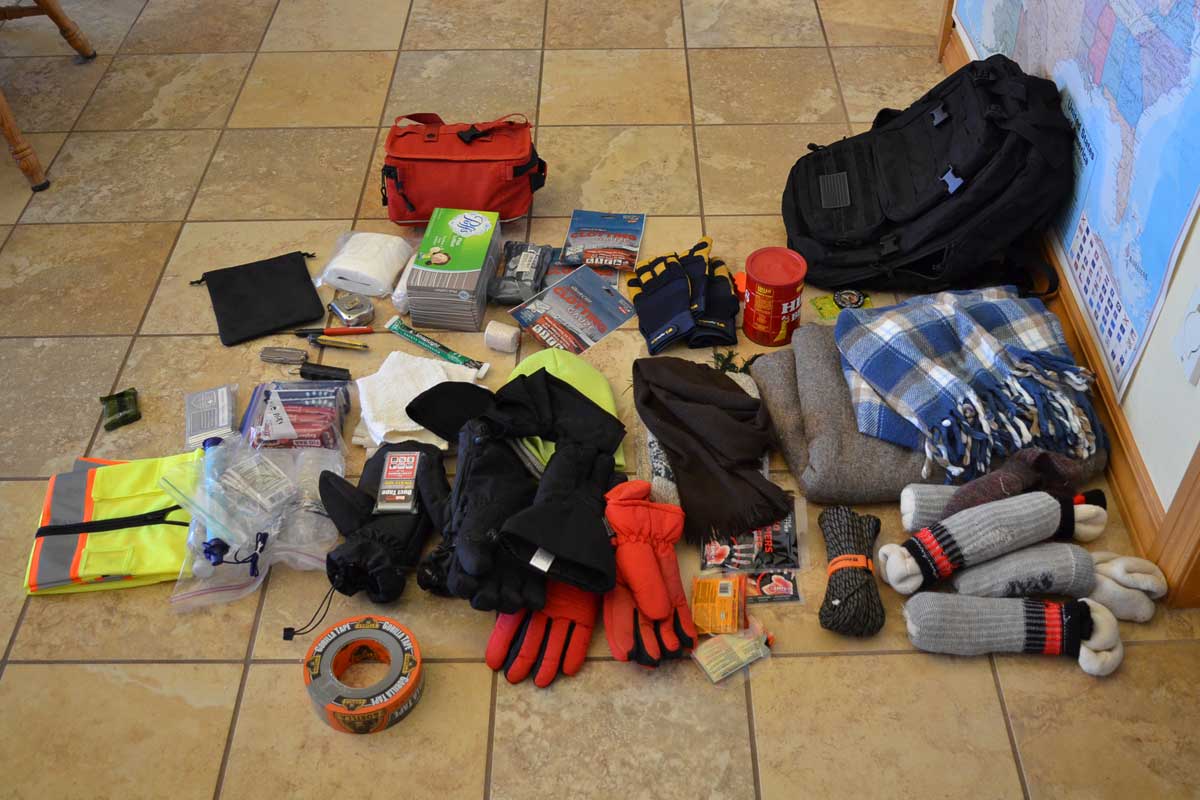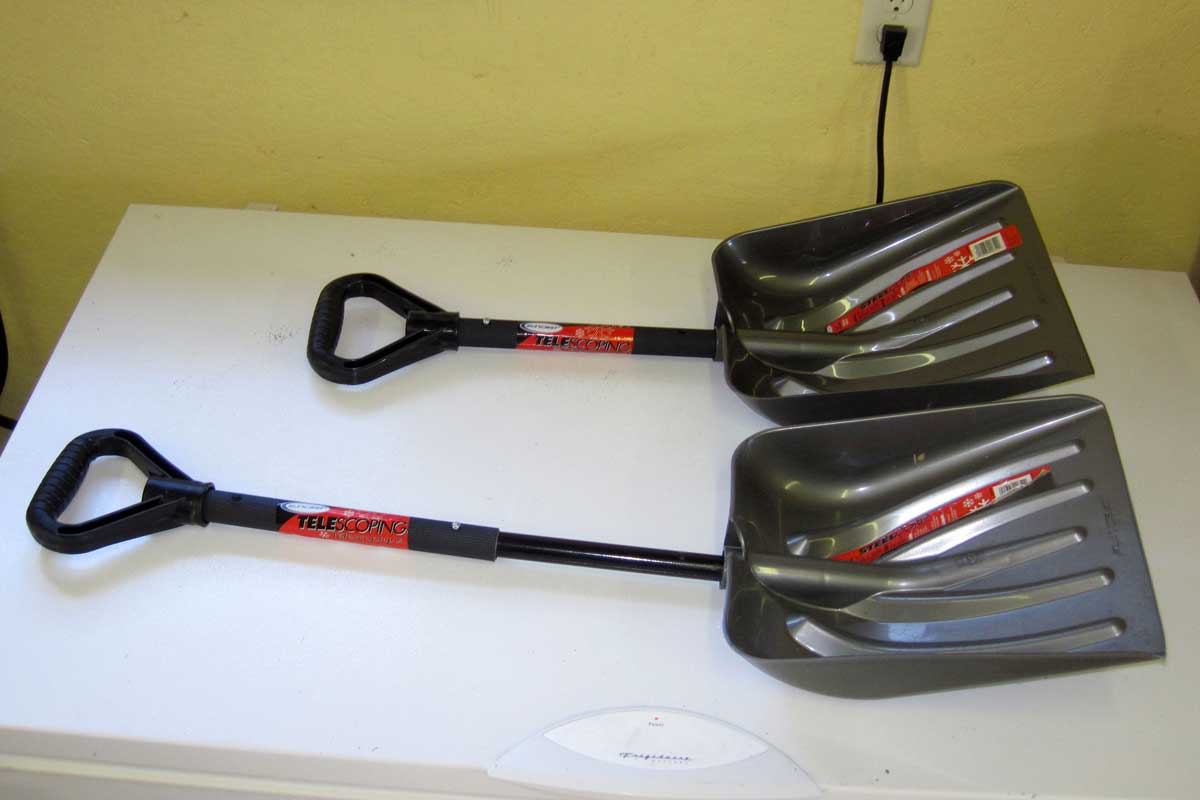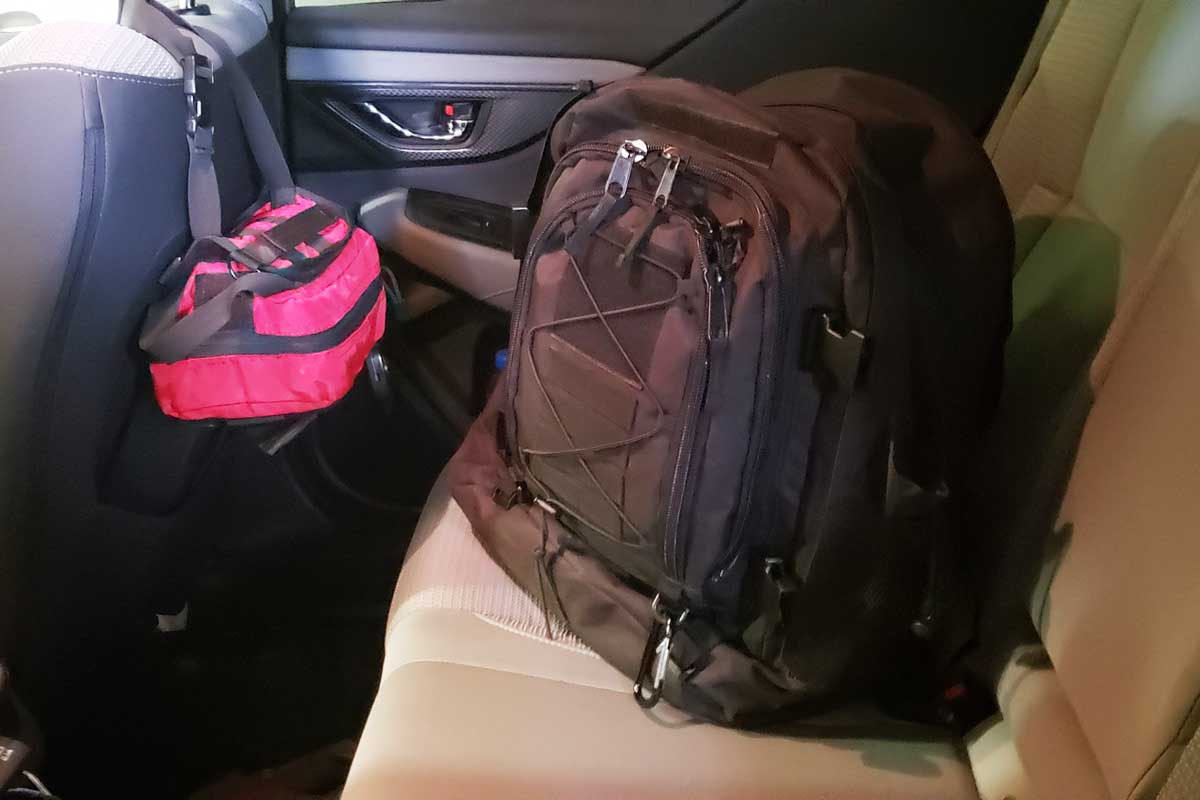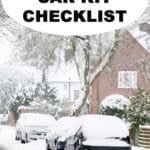Winter Car Kit Checklist for Cold Weather Travel
This post may contain affiliate links. Read my full disclosure here.
Over the years, I’ve had to do a lot of winter driving. As the eldest in the family, I became the family chauffeur once I got my license. Later, I did monthly round trips between Green Bay and Duluth, Minnesota for Guard duty. I still end up regularly driving around the state for work, so I always have a winter car kit stocked when cold weather hits.
Our son ended up traveling home in an ice storm last week, so I decided it was a good time to recheck the kits. I cover the basics, plus gear you may need to deal with accidents and travel delays.

Basic Winter Car Kit
The most basic winter car emergency kit should include:
- Ice scraper and snow brush
- Jumper cables
- Blanket
- Flashlight with extra batteries
- First-aid kit
- Non-perishable snacks and bottled water
- Small shovel and sand (for traction if you get stuck)
Store the kit in your back seat instead of the trunk, in case you can’t get to your trunk. It’s good to have a cellphone so you can call for a tow truck, if needed, or let other know where you are.
Check out the Winter Vehicle Preparation Checklist for recommended cold weather maintenance.

Full Winter Emergency Car Kit
In addition to the basics, I carry winter weather gear, survival supplies, and tools for roadside repairs.
First Aid Kit
You should have a basic first aid kit or trauma kit, depending on your skill level. Make sure you know how to use items in the kit. We have tourniquets and Quick Clot in our kits, and it’s important to use those correctly.
See our Best First Aid Kit article for recommendations.
Sleeping Gear
If you are stuck in the car off the road or snowed in somewhere overnight, sleeping gear is a good idea.
- Small pillow
- Wool Blanket – 100% wool is best, but they are really pricey. Wool keeps you warms even when wet. It doesn’t burn easily, so you can also use it to put out a fire.
- Warm Sleeping Bag
- Mini emergency blankets – these can be used in a lot of creative ways, such as a moisture barrier. Cover the windows to reflect the cold out and warm in.
Clothing for your Winter Car Kit
- Hats – Stash an extra hat or two in the trunk and inside the car.
- Layers – Long johns in your size and a full change of layered working clothes including underwear. If you get wet a set of dry clothes can make a huge difference.
- Outer jacket that stops the wind, if you’re not wearing one.
- Gloves – Large Winter gloves or mittens can go over your existing gloves for extra warmth
- Wool Socks – large sized (they should not be too tight). Large wool socks can do double duty as mittens.
- Scarf – You’ll be glad to have it if you end up walking.
- Boots – If you’re not wearing them, have them along. You could be going for a quick trip, and end up needing to walk long distance in the snow. Make sure to have room for wool socks. Even waiting in a car is better with heavy boots to keep your feet warm.
Food
- Snacks – include shelf stable snacks such as granola bars, jerky, or dried fruit.
- Water – Make sure you empty a little water out of each bottle. That way, the plastic won’t burst if they they freeze.
- Dry drink mix for the water, if you’re one of the people who don’t like plain water.

Winter Emergency Car Kit Tools
- Snow and ice scraper with brush
- Car shovel – These are small, collapsible shovels for emergency use.
- Sharp Rescue Knife. Consider a rescue knife. It can break a car window and cut a seatbelt. Keep it within reach of the driver.
- Flashlights. Remember to have at least one waterproof flashlight (look for IPX rating). See also “Best Cheap Flashlight” and “Brightest Flashlights” articles. Swap batteries each SPRING and FALL, and keep extra batteries in cold weather.
- Jumper Cables – cold decreases battery life , and the heavier gauge gets more power to the car being jumped. The higher 800 amp cable is better than the 400 or 600 amp cables.
- A Leatherman multi-tool for small repairs
- Car Fire extinguisher
- Quick flat recovery Fix a Flat (or similar) for flat tires
- Regular Road Flares or Electronic Road Flares. Electronic flares avoid the risk of fire, but require 6 AAA batteries.
- Brightly colored Reflective Vest. A reflective jacket or poncho makes you more visible.
- Tire Iron or Lug Wrench and a heavy duty scissor car jack or bottle jack with stand.
Other Supplies
- Heavy Tow Strap – a strap is a LOT safer than just rope or chain.
- Duct Tape has an insane number of uses. It can seal a crack in a window, hold on a broken mirror, or tape a trunk shut. In first aid situations – immobilize a limb, create temporary splints and as a bandage. We keep a roll in each vehicle.
- Fuse kit – various types.
- Paracord to make makeshift tent, tie a door closed, or hood. This version is very versatile. Tie something to the top of the vehicle.
- De-Icer Windshield Washer Fluid
- Sharpie pens can be used to write on pretty much anything, which is useful in an emergency.
- Emergency Phone Numbers – keep a paper list in your car. Your cellphone might be dead, but the police or a good Samaritan may have a phone.
- Cell phone charger cable
- Empty Gas Can – Extra gas lets you keep the engine running more to keep you warm. Just make sure the exhaust is kept clear.
Personal Items
- Keep an extra pair of prescription glasses, sunglasses and/or contacts in your car. Remember, the sunglasses are as important in the winter snow as in the summer glare.
- Medications, and other items like aspirin or ibuprofen. Keep these in your first aid kit.
- Kleenex, some wipes
- Toothbrush, floss and toothpaste
- Lip balm
- Feminine hygiene items or adult diapers, as needed
- Baby/toddler items, if needed
- Deck of cards and/or other travel games. These are great if you are stuck in the snow or a hotel.
- A notepad to leave notes or doodle.
- A towel wrapped around a few cloth diapers, wash cloth or wash cloths is a great add on. You can use the wipes to clean up and towel to dry off. Moist wipes are a good option also, a small package can help clean up a mess.
- Couple rolls of toilet paper (in zip lock bags) and a couple of garbage bags. The garbage bags are multi-function. If you had a window blown out you can use the bag with Duct Tape to “seal” the hole to keep you warm.
Warmth
- Hand Warmers – Warm hands, feet, or anything else.
- Lighter or waterproof matches
- Candle in a metal container or Sterno – You can use this for heat or melting snow for water.
** Note: Be careful with open flame inside a vehicle. Nearly everything inside a car is flammable. ALSO flame can use up your oxygen if the car is too tight. Keep your exhaust pipe clear and crack a window open if you feel light headed.
Would you like to save this?
Traction
Ashes or sand – put some under your tires for traction when stuck. Though commonly recommended, clay kitty litter gets slippery when wet.
Tire chains – especially if you don’t have snow tires. Research the right chain type for your vehicle.
Snow tires – Nokian or Michelin are good snow tires. Make sure to check that your spare tire is in good condition.

How to Store Your Winter Car Kit
We recommend a large Tactical Backpack which holds 40L and expands to 64L. We have two and like them. It has multiple compartments and a belt strap in case you need to hike home in an emergency. Some people use totes to store their winter car kit.
I keep the shovel and scraper separate from the rest of the pack, and food items separate from combustibles. If you pack nothing else, you should have hats and blankets enough for all regular passengers and a good ice scraper. The snow shovel and jumper cables are the next most important.
Buy a Winter Emergency Car Kit
You can buy a pre-packed winter car survival kit, but most of them are pretty skimpy, or just have car related items.
The “Always Prepared 125-Piece Roadside Assistance Auto Emergency Kit ” looks to be better than most. But even this fairly good one needs extras.
We suggest you add: flashlights, duct tape, Quick Clot, Sharpie pens, wool blanket, fire extinguisher, ice scraper, and a shovel.
Don’t Forget Contact Information
A friend of mine reminded me about another consideration – emergency phone numbers. Paper and electronic.
“As an EMT, I was trained to look at victims cell phones (if they were unconscious) and I would look in their contacts list for a number listed as “ICE”. Ice stands for “In Case of Emergency”. Everyone should have a number for US to contact in case of an accident or medical emergency.”
Since you SHOULD lock your phone, consider leaving a ICE paper note or emergency contact list in your glove compartment, with names numbers and relations. Alternately leave it in your wallet or purse.
Stay Safe this Winter!
Let us know if you pack anything we missed, and please pass this post along to friends if you find it useful.
Related Articles
Car Won’t Start in the Cold? Check Out these Troubleshooting Tips
All Season Roadside Emergency Kit
The Ultimate Guide to Practical Cold Weather Clothing

This post was written by August Neverman IV. August has a strong background in emergency preparedness. He served on several emergency preparedness teams during his tenure at Brown County WI Government, the Medical College of Wisconsin, HSHS, a 13-hospital system and emergency response training during his time with the Air Force and Air National Guard. Learn more about August.
Originally posted in 2011, last updated in 2024.


Love to read this article. I am totally inspired by your work and got some great ideas. Thanks and keep sharing 🙂
There’s more than one reason to keep your fuel tank topped up in the winter. In the cooler months condensation occurs in fuel tanks that are less than full. If you get enough water in your fuel tank from condensation, it will foul your carburetor or fuel injector system causing your vehicle to stop running. Many people blame that on the gas stations where they buy fuel but it’s more often just condensation. I use a large plastic tub with a lid for my vehicle emergency kit. I keep a light weight & a heavy weight blanket along with a couple of fleece throws. Some spare seasonal clothing, a full change including a hat. A spare pair of walking shoes. Some umbrellas & cheap plastic ponchos in colors not found in nature. (in other words, highly visible) Flashlights, (with emergency flashers built in) essential tools, a homemade BSA Buddy Burner, a 1 quart enameled coffee cup, some coffee & tea bags, individual sugar & honey packets, bottled water, a six pack of ramen noodles, (cooks in 3 minutes) a first aid kit, a small USB solar battery charger & some reading materials. And my cell phone goes with me wherever I go. In the days before the prevalence of cell phones I have been stuck on the roadside for several hours on more than one occasion, in all types of weather. So I eventually learned what I needed to keep with me at all times. Experience is the best teacher… =/
You are right! Tell your friends, family and neighbors. Everyone should take your example and make it fit their area. Laurie and I lived near Duluth Minnesota and the freezing weather was VERY HARD on cars (and people). When we switch from summer to winter we swap walking shoes for snow boots and leave the work gloves but ADD gloves, mittens and hats (stuffing the gloves/mittens inside the hat). We also throw in wool socks which can double as gloves. We suggest you keep a wool blanket in the car also, it wont burn easily so it can be used to put out a fire or just wrap up in the back seat to keep warm on a long trip. Wool will also keep you warm even if its wet. A kneeler pad can be a godsend when its -20F and your are kneeling to change a tire or clear the car. The quick way to make sure the gas doesn’t get water/moisture is to add HEET to the car gas tank every other time you add fuel. Chocolate bars and other hard candy are good for a quick pick me up and last nearly forever. All the best!
Good post. A few more things that weren’t said in the article.
– Keep as much of the food and meds in a wide-mouth thermos. It’s not just high temperatures that affect shelf life and potency, temperature variations as well. When it’ll be freezing outside and inside the trunk, the thermos should keep the temperature inside more or less constant.
– A shovel that’s not telescopic is less likely to break. Mine is from Fiskars, a reputable Swedish company, and it’s pretty solid. It wasn’t expensive either.
– Get one of those flashlights that are hand-crank. That way, you won’t have any surprises. Keep in mind batteries discharge quicker in cold temperatures.
Dan “Survival” Sullivan
This is a very good list of item to store in your car. I would like to add that just in case things get wet, put your TP in a ziplock bag to keep it dry. I’ve had things break and get stuff soaked in the bin I car in my car, but the TP has always remained dry.
Thanks, Larry. I’ll add a note about that.
Thanks for a very comprehensive list and great ideas from all. Did I miss a flashlight? I also have a NOAA emergency radio (crank up style). And a tarp might be useful if you have to change a tire in the snow (or for shelter). I would add for 2nd or 3rd tier of emergency readiness for car … I have a tool that has a covered razor for cutting off a seat belt if it gets stuck in an accident situation and another tool on it is that piece you can use if you spin into water and the windows short circuit to break them and escape plus it has a flashlight with it. Granted you may never need it but doesn’t hurt to have it on hand.
I never thought to carry a fire extinguisher in the car I may add that. And I also like the idea of using a tote container to keep all the e-items in the trunk. I would keep the wool or fleece blankets in the car ( if rolled up good pillows). And I have 2 seat back organizers for hand warmers, small first aid items, tissues, wipes, cheap rain ponchos, extra gloves, maps etc. and sm. food snacks. Extra sm. umbrella in glove compartment (can help with snow). Thanks again. Time to make sure everything is there for 4 riders.
Flashlight is on the list right after water. 🙂
Thanks for your input. (That reminds me – I need to stick the umbrella back in the van.)
O I forgot to add, for those who have allergies to wool, there are fabrics which wick moisture away from the body. Sometimes manmade can be a good thing. I’ve used these for other uses so I know they work.
I bought several of those one way valve type plastic bags. I keep a change of clothing for each person which rides in the car. They are reusable and since they are one-way they work for keeping those old/wet clothes in and can be rolled up to get the air out. Much better than using food saver bags. I will be using many of these ideas this year with the new used car. Thanks. 🙂
What the hell do u need an empty gas can for if ur stuck and run out of gas, your not going to walk anywhere in snow like ur having throughout the country today. Its a little unsafe but so is gas in the car tank… I would want a little emergency gas available for those few extra hours of warmth before u run out of gas to put in the tank. just wondering
If you’re carrying around a gas can with just a little gas, the motion of the vehicle will cause it to aerosolize, effectively creating a bomb, since the fumes burn much more readily than liquid gas. I really wouldn’t recommend this. No, you’re not likely to be hiking with 3-5 feet of snow on the ground, but if you have any sense or warning, you’re not likely to be out driving in it, either. The gas can would honestly be pretty low on my list – BUT – say you are stuck for a while and drain your tank, then can get out, but you have no gas to do so. Catch a lift to the service station, get your gas, get a ride back, put it in your tank and get out instead of calling a tow truck.
Don’t forget medications, pain pills, asthma inhalers, etc. A small backpacker stove and some ground coffee or tea can do wonders to lift the spirits.
I saw on a TV talk show that a bag of kitty little is good to have in truck in winter months. It will help get out of slick road condition if you get stuck and need some traction.
correction:
” kitty litter in trunk.. sorry :>)
Industrial Trash Bags (3 or 4) (bought at Lowe’s or Home Depot) can be used to keep you dry and warm if used over clothes or can be used to make a temporary shelter if need be.
Plastic grocery sacks or small drawstring bags to cover exterior mirrors. Anytime I think it might ice over I bag my mirrors so I don’t need to risk damaging them.
Smart.
cool idea
I always have a bag of kitty litter or old rugs in the trunk in winter. They help give you the traction you may need to get off a patch of ice
old rugs ! awesome idea ! or more wool blankets …
I found those shovels, or ones just like them at least at Staples last year on clearance…$3 each, so bought one for each vehicle. Glad to hear they work well as we never used them…winter was ending. This is a great reminder post. Thank you!
Unless the snow is really hard packed or more ice than snow, they do a decent job. (Of course, ice is problem with most plastic shovels – and everything else.)
This is such a helpful post. Definitely bookmarking it to take a look at again as winter approaches. Thanks so much!
Thanks, Jodi. I’m really hoping we don’t have another winter like the last one.
Thank you all for these smart tips!. I’d been in a ditch in a 1982 Ford Mustang II due to wintery black ice in Nebraska years ago. I had… jumper cables and a sun shield.. It was COLD and getting colder.I was looking at spending the night in my car. Fortunately, a fellow church member spotted my car and drove me to a nearby church of ours. Never want to be in that tight spot AGAIN. EVER.
Black ice is nasty! My sister and I ran into miles and miles of it on our way back from Chicago to northwest WI one winter. Traffic had slowed to a crawl, and then pretty much stopped. We ended up taking shelter with a benevolent trucker at a truck stop. He let us use his sleeper while he slept behind the wheel. Awful nice gentleman to run into on a cold and dangerous night.
It’s also a good idea to have clothes and blankets in bright colors. If you have to leave the vehicle, you want to be highly visible. Construction or hunting attire is not fashionable, but it can be a lifesaver on a dark road at night.
All vehicles should have an ABC type fire extinguisher in the passenger compartment, where the driver can get to it easily. If (heaven forbid) there is a fire, you need to be able to fight through the flames, to get to safety.
The single most important piece of vehicle emergency equipment anyone can carry is a cel phone.
Are the water bottles in the img evian?
No. I can’t remember the brand name at the moment, but it was a local store brand.
really should only have the water bottles 2/3rds full or a freeze will burst your bottles
My water bottles never burst. They are useless here of course because they stay frozen all winter.
Toilet paper. I know the city slickers might find this one strange, but out in the country, in an emergency, I like to have options! LOL Wipes might be better – could serve multi-purposes – depending on local average temperatures of course!
This is true. You just never know how long you may be stuck.
You have forgotten to say that EVERYthing should be WOOL, not any kind of acrylic, Wool is thermodynamic so cools you down and warms you up so if you have to walk you wont sweat then chill … this is essential.
You will have a hard time finding pure wool these days. They are almost always a wool ‘blend’ using some form of polyester…yuk!!!
Also, I wish I could carry this in my vehicle, however I am a rural mail carrier, and have to use all the space for mail. I worry I might someday get caught and need this stuff, but won’t have it. I do manage to make room for a medium sized tool tote with a great first aid kit I put together myself. The clothing and blankets and most of the other tools, no room.
A blanket might be something you could stuff under the seat, just in case. I did find real wool blankets at Fleet Farm. They were old European army surplus – complete with straw sticking to them. (Maybe former horse blankets?) Some of the new blends aren’t so bad, especially for under layers, but wool is still a reliable choice.
What about the emergency blankets that are reflective? They are supposed to hold your heat in and are very small. If you don’t have room for a real blanket, perhaps those would work??? I also read that you could pack things inside a plastic barrel like what 5 gallon paint comes in so that it could double as a water carrier. Including a metal coffee can gives you the option of having something you could heat water with. Include some matches in a water proof container. If you were stuck somewhere remote, this might be good.
They work, the reflective material helps BUT… but no where near as good as a real wool blanket. The ones I have used tear easily (some of the more expensive ones are tougher). We suggest both the emergency blanket AND the wool blanket. The combo can be very good in a bad situation. The emergency blanket can be used as a ground liner to keep moisture from getting into the wool and reflect heat back up. They also can be used as a rain or snow shield (as long as it doesnt tear). It can be used to reflect heat from a fire or heated rocks again as long as it doesnt tear a lot. Get a couple different brands and try them outside at a football game or other winter sports event. Most are flimsy and tear far too easily. A couple of alternates are the “All Weather Blanket” or the “woobie“
I’m glad you shared this in the NLN Lounge. Now that my car is ready for winter since the inspection is done, I need to get the inside of the car ready.
I need to get in for new tires before the weather gets rough. Glad I’m not out in the mountains. Thanks for stopping by.
I always add “kitty litter” to the list, helps if some one needs traction in a slippery situation. & Car Games or Books to pass the time till help arrives.
I second that! I’ve seen plenty of little sports cars getting stuck going into their uphill driveways and sliding into embankments. Especially with the snowplow humps. It’s hard for them to get traction already but even harder when they’re on top of something and you can’t dig out under the car.
Make it’so the old fashioned kitty litter, and not the newer clumping kind that will turn to mush in the snow.
Yes, nothing clumping or clay based. Either will get things more slippery, not less.
Auto grade DE diatomaceous earth … is not very heavy and stays dry
Good post. We are taking our oldest son to college in Utah after the holidays so it is good to have a reminder on winterizing the car and supplies..It’s been a while since we drove in winter country..
If you have little ones, packing some powd formula and diapers and wipes for emergencies are a good idea. We also keep a spare set of clothes including socks and underwear for everyone in the car. Nothing nice, but good to have if you get soaked trying to get said car started or unstuck. Or if one of you kids is a random vomiter. Yep, those clothes have come in handy more than a few times.
Yes! Rallllpppphhh rode with us a time or two in our car. From that day forward we were prepared!
Oh dear… Thankfully we’ve never been blessed with that one.
Don’t pack kiddies clothes that are the exact size. Pack small adult size stuff or even larger. Big can be shortened, pinned, belted etc where as clothes that are too small are useless.
I used a vacuum packer to condense down clothes for the “kid pack” helps with saving space.
Using the vacuum sealer is a great idea for keeping everything dry and compact. Thanks.
You also might want to carry an empty gas can. Gas stations nowadays don't have a can to loan out if you run out of gas and have to walk. If you drive a pick-up, carry a can in the bed during storms.
In addition to a blanket, I carry a sleeping bag…
I pack our kits in those plastic totes. Also, add a roll of TP (for starting a fire if need be and for "normal use") You also might want to add a small bottle of hand sanitizer, it works for clean ups and as a fire starter as well. I was thinking about adding one of those power packs this year, just in case the battery in my truck goes dead, I can still charge up my phone as I wait for help.
Good reminders! Thank you!